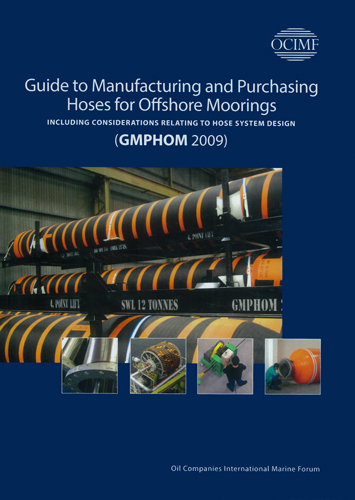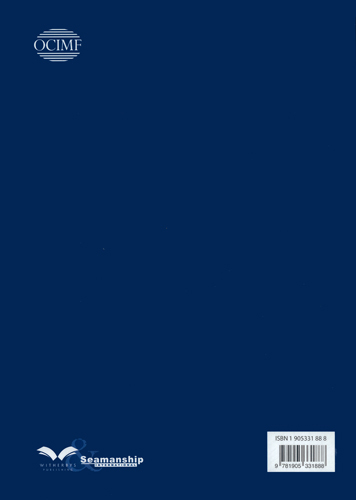Guide to Manufacturing and Purchasing Hoses for Offshore Moorings (GMPHOM 2009)/Руководство по производству и закупке шлангов для морских причалов (GMPHOM 2009)
Книга на английском языке
This Guide, which supersedes the 4th edition of the 'Guide to Purchasing, Manufacturing and Testing of Loading and Discharge Hoses for Offshore Moorings', published in 1991, has been prepared by OCIMF with the purpose of providing technical recommendations and guidance to ensure the satisfactory performance of elastomer reinforced, smooth bore, oil suction and discharge hose commonly used at offshore moorings. The recommendations and guidance within this Guide shall not be construed as establishing standards or requirements for application to offshore equipment. The 4th edition published in 1991 will be withdrawn in June 2012. Although manufacturers may choose to continue to be guided by 4th edition until it is withdrawn, this 5th edition reflects a major review and enhancement of the 4th edition. The 1993 OCIMF publication'SPM Hose System Design Commentary'is now superseded by this Guide and relevant issues are now included in Part 5.
Contents
Purpose and Scope Hi Definitions
Section
Technical Requirements for Commercial Hose
1.1 Scope
1.2 Performance Requirements
1.2.1 Rated Working Pressure
1.2.2 Operating Pressure Range
1.2.3 Flow Velocity
1.2.4 Resistance to Temperature, Oil Products and Ageing
1.2.5 Hose Allowable Axial Load
1.3 Length
1.3.1 Standard Hose Length
1.3.2 Tolerances on Length
1.3.3 Elongation
1.4 Flexibility
1.4.1 Minimum Bend Radius
1.4.2 Hose with Special Stiffness Requirements
1.4.3 Reeling Hose Systems
1.5 Construction
1.5.1 Hose Construction
1.5.1.1 Construction of Lining
15.1.2 Construction of Body
1.5.1.3 Construction of Cover
1.5.2 End Fittings
1.5.3 Electrical Continuity
1.6 Submarine Hose
1.6.1 Depth Requirements
1.6.2 Provision of Floats
1.6.3 Weight Tolerances
1.6.4 Marking
1.7 Floating Hose
1.7.1 General
1.7.2 Distribution of Buoyancy
1.7.3 Colour of Cover
1.7.4 Buoyancy Requirements
1.8 Tanker Rail Hose
1.8.1 Buoyancy Material
1.8.2 Flexibility
1.8.3 Weight Tolerances
1.8.4 Reserve Buoyancy
1.8.5 Lifting Lugs
1.8.6 Marking
1.9 Double Carcass Hose
1.9.1 General
1.9.2 Construction
1.9.3 Leak Detection
1.10 Reinforced Hose
1.10.1 Reinforcement
1.10.2 Marking
1.11 Reeling Hose Systems
1.11.1 General
1.11.2 Considerations Applicable to Reeling Systems
1.12 Hoses for Offshore Marine LPG Applications
Section 2
Acceptance Tests; Inspection Procedures and Delivery
2.1 Acceptance Tests
2.1.1 General
2.1.2 Material Tests
2.1.3 Adhesion Tests - Body and Cover
2.1.4 Buoyancy Material Adhesion Tests
2.1.5 Weight Test
2.1.6 Minimum Bend Radius Test
2.1.7 Bending Stiffness Test
2.1.8 Torsion Test
2.1.9 Tensile Test
2.1.10 Hydrostatic Pressure Test
2.1.11 Kerosene Test
2.1.12 Vacuum Test
2.1.13 Electrical Test
2.1.14 Float Hydrostatic Test
2.1.15 Lifting Lug Acceptance Test
2.2 Inspection
2.3 Inspection and Test Certificates
2.4 Manufacturer's Report
2.5 Marking
2.6 Quality Assurance
2.7 Packing
Section
Technical Requirements for Prototype Hose Approval
3.1 Scope
3.1.1 Prototype Test Requirements
3.2 Prototype Hose
3.2.1 Diameter
3.2.2 Length
3.2.3 Rated Working Pressure
3.3 Prototype Document Package
3.4 Required Tests for Prototype Hose
3.4.1 Material Tests
3.4.2 Nipple Adhesion Tests
3.4.3 Adhesion Tests - Body and Cover
3.4.4 Buoyancy Material Adhesion Tests
3.4.5 Buoyancy Recovery Test
3.4.6 Weight Test
3.4.7 CollarTest
3.4.8 Torsion Test
3.4.9 TensileTest
3.4.9.1 On Empty Hose
3.4.9.2 On Pressurised Hose
3.4.10 Dynamic Test
3.4.10.1 Bending Load
3.4.10.2 Tensile Load
3.4.10.3 Torsion Load
3.4.11 Minimum Bend Test Radius
3.4.12 Bending Stiffness Test
3.4.13 Hydrostatic Pressure Test
3.4.14 Kerosene Test
3.4.15 Vacuum Test
3.4.16 Electrical Test
3.4.17 Burst Test
3.4.18 Double Carcass Burst Test
3.4.19 Leak Detection System (Double Carcass Hose)
3.4.20 Crush Test
3.4.21 Lifting Lug Test
Section 4
Purchaser's Inspection Guide
4.1 Scope
4.2 General
4.2.1 Purchaser's Inspection Requirements
4.2.2 Inspection Schedule
4.2.3 Facilities for the Inspector
4.2.4 Role of the Inspector
4.3 Documentation
4.4 Inspection Procedures
4.4.1 General
4.4.2 Material and Pre-Build Checks
4.4.3 In-line Inspection
4.4.4 Adhesion Tests - Body and Buoyancy Material
4.4.5 Hose Handling
4.5 Acceptance Tests
4.5.1 Minimum Bend RadiusTest
4.5.2 Bending Stiffness Test
4.5.3 Torsion Test
4.5.4 TensileTest
4.5.5 Hydrostatic Pressure Test
4.5.6 Kerosene Test
4.5.7 Vacuum Test
4.5.8 Electrical Test
4.5.9 Float Hydrostatic Test
4.5.10 Lifting Lugs
4.6 Test Certificates
4.7 Pre-Shipment Inspection and Packing
Section 5
Considerations Relating to Hose System Design
5.1 Hose System Designs
5.1.1 Catenary Anchor Leg Mooring (CALM)
5.1.2 Single Anchor Leg Mooring (SALM)
5.1.3 Multi Buoy Mooring (MBM)
5.1.4 Tandem Mooring
5.2 Floating Hose String Lengths
5.2.1 Catenary Anchor Leg Mooring (CALM)
5.2.2 Multi Buoy Mooring (MBM)
5.2.3 Tandem Mooring
5.3 Use of Electrically Discontinuous Hoses
5.3.1 Manifold Connection
5.3.2 Cathodic Protection Systems
5.4 Marine Breakaway Couplings
5.4.1 Factors to Consider
5.4.2 Guidance on Positioning of MBC
5.4.3 Use of MBCs in Reeling Flose Systems
5.5 Recommended Actions after a Surge Event
5.6 Hose Lifting Weights
Appendices
A Hose Data Specification Sheet
В Purchaser's Inspection Requirements
C Example of Inspection and Test Certificate
D Reel Information Sheet
E Reference Documents and Standards




